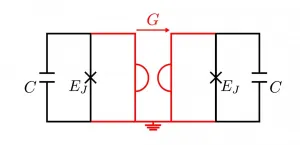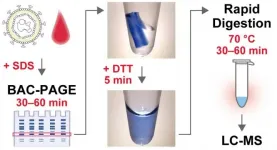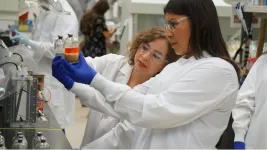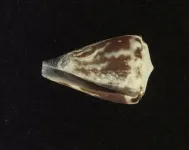INFORMATION:
Physics of tumours: Cancer cells become fluidised and squeeze through tissue
Hope for improved diagnosis and therapy of cancer
2021-02-18
(Press-News.org) Working with colleagues from Germany and the US, researchers at Leipzig University have achieved a breakthrough in research into how cancer cells spread. In experiments, the team of biophysicists led by Professor Josef Alfons Käs, Steffen Grosser and Jürgen Lippoldt demonstrated for the first time how cells deform in order to move in dense tumour tissues and squeeze past neighbouring cells. The researchers found that motile cells work together to fluidise tumour tissue.
Käs led the research project in cooperation with Professor Lisa Manning from Syracuse University (US) and Professor Bahriye Aktas from Leipzig University Hospital. They have now published their findings in "Physical Review X", a leading journal that primarily publishes groundbreaking research results.
"These first observations of a phase transition in human tumours change our basic concepts of tumour progression and could improve cancer diagnosis and therapy," said Käs, who has been studying the physical properties of cancer cells for years. He said the research showed that human tumours contain solid and fluid cell clusters, which would be a breakthrough in scientists' understanding of tumour mechanics. He added that the results form the basis for the first procedure with which metastatic cancer cells can already be detected in the tumour.
In tumour samples from patients at Leipzig University Hospital, the researchers found regions with motile cells as well as stable, solid-like regions with no cell movement. From a physical point of view, cells should not be able to move in the dense tumour mass - tumours are so densely crowded with cells that motion would be inhibited in any typical material.
The researchers therefore developed a new approach to live tumour microscopy by fluorescently staining human tumour samples immediately after surgery, allowing them to observe cell movement live. This led them to discover that, contrary to all previous findings, this cell motility does indeed take place and is associated with strong nuclear deformation. They observed how cells and their nuclei literally squeeze through the tissue by becoming severely deformed.
"Cells in biological tissues behave much like people in a bar. At low densities, they can move freely. However, movement becomes difficult when things get very crowded. But even in a crowded bar, you can still squeeze past if you turn sideways. This is exactly the effect we see in tumour tissues," said Käs. The researchers believe this phase transition explains how cells can move and multiply in a tumour, eventually leading to metastasis. The fluid tissues showed elongated, deformed cells and nuclei. Static images of elongated cell and nuclear shapes could thus serve as a fingerprint for the metastatic aggressiveness of a tumour.
"These are spectacular results from the field of cancer physics. We now need to investigate whether the fluid regions can predict tumour aggressiveness. Here we have found a cancer marker that indicates active, motile regions and that is based on a simple physical mechanism," said Steffen Grosser. Professor Käs is currently embarking on a clinical trial to investigate the potential of cell and nuclear shape as a new tumour marker that could be used to examine and treat patients in a much more targeted way than before.
ELSE PRESS RELEASES FROM THIS DATE:
Blueprint for fault-tolerant qubits
2021-02-18
Building a universal quantum computer is a challenging task because of the fragility of quantum bits, or qubits for short. To deal with this problem, various types of error correction have been developed. Conventional methods do this by active correction techniques. In contrast, researchers led by Prof. David DiVincenzo from Forschungszentrum Jülich and RWTH Aachen University, together with partners from the University of Basel and QuTech Delft, have now proposed a design for a circuit with passive error correction. Such a circuit would already be inherently fault protected and could significantly accelerate the construction of a quantum computer with a large number of qubits.
In order to encode quantum information ...
A novel gel electrophoresis technique for rapid biomarker diagnosis via mass spectrometry
2021-02-18
Mass spectrometry (MS) is a powerful method for biomarker analysis because it enables highly sensitive and accurate measurement of target molecules in clinical samples. The application of MS to clinical diagnosis, such as neonatal metabolic screening, has been progressing with a focus on metabolite markers. MS measurement of proteins is currently mainly used for novel marker discovery studies, but there is a growing interest in its application in clinical marker diagnosis as an alternative to immunoassays.
MS-based quantification of protein biomarkers is mainly performed by a bottom-up approach using peptide fragments obtained by enzymatic ...
Youth exposed to natural disasters report low post-traumatic stress
2021-02-18
A study of over 1,700 U.S. young people exposed to four major hurricanes found that just a few of them reported chronic stress, and the trajectories among most youth reflected recovery or low-decreasing post-traumatic stress (PTS) symptoms, according to research recently published in JAMA Network Open.
Titled "Trajectories of Post-traumatic Stress in Youths After Natural Disasters," the inquiry, conducted from August 2017 to August 2020, combined data from four studies of youths ages six to 16 who attended schools near the respective destructive paths of Hurricanes Andrew (1992), Charley (2004), Ike (2005) and Katrina (2008), from three to 26 months following the disasters. Fifty-four percent of ...
Waste into wealth: Harvesting useful products from microbial growth
2021-02-18
Ancient alchemists dreamed of transforming base materials like lead into gold and other valuable commodities. While such efforts generally came to naught, researchers today are having some success in extracting a variety of useful products like aviation fuels, lubricants, solvents, food additives and plastics from organic waste.
The trick is accomplished with the aid of specialized bacteria, whose metabolic activities can convert simpler chemicals into useful products through a microbial growth process knows as chain elongation.
Anca Delgado, a researcher in the Biodesign Swette Center for Environmental Biotechnology at Arizona State University, has been exploring the phenomenon. In a new study, she describes ...
Immunosuppressive cell and cytokine response linked to bone nonunion
2021-02-18
EUGENE, Ore. -- Feb. 18, 2021 -- An abnormal suppression of the immune system linked to the onset of numerous diseases has been associated with poor functional regeneration of traumatic bone injuries.
Levels of immune cells and proteins circulating in the blood following traumatic injury combined with advanced data analytics could predict whether patients are likely to respond to treatment, said Robert Guldberg, executive director of the Phil and Penny Knight Campus for Accelerating Scientific Impact.
The project -- detailed in a paper published online ahead of print in the Proceedings of the National Academy of Sciences -- identified ...
Study finds risk factor for blood clots occurs in more than 10 percent of transgender men using testosterone
2021-02-18
WASHINGTON--A potentially dangerous side effect of testosterone therapy for transgender men is an increase in red blood cells that can raise the risk of blood clots, heart attack or stroke, according to a new study published in the Endocrine Society's Journal of Clinical Endocrinology & Metabolism.
Gender diverse people make up an estimated 0.6% of the U.S. population and are defined as having gender identity that is not aligned with their sex recorded at birth. Transgender men often undergo testosterone therapy as part of their gender-affirming treatment. Erythrocytosis, a condition where your body makes too many red blood cells, is a common side effect of testosterone therapy that can increase the risk of blood clots, heart attack or stroke.
"Erythrocytosis is common ...
Increasingly fragmented tiger populations may require 'genetic rescue'
2021-02-18
Despite being one of the world's most charismatic species, tigers face uncertain futures primarily due to habitat fragmentation, human-wildlife conflict and poaching. As global tiger populations decline, so does their genetic diversity. But until now it's been unclear how the animals' dwindling numbers are affecting them at the genetic level.
To find out, researchers at Stanford University, the National Centre for Biological Sciences, India, and various zoological parks and NGOs sequenced 65 genomes from four of the surviving tiger subspecies. Their findings confirmed that strong genetic differences exist between different tiger subspecies but showed, surprisingly, that these differences emerged relatively recently, ...
Transit-oriented development causing displacement: study
2021-02-18
Transit-oriented development--which concentrates high-density housing, commercial activities and public spaces around a rapid transit station--can both be a boon and a bane for communities, suggests a new UBC study.
"Transit-oriented development (TOD) can reduce traffic congestion and air pollution, encourage active mobility, and revitalize a neighbourhood," explains study author Craig E. Jones, a PhD candidate in geography and the research coordinator for the Housing Research Collaborative at UBC's faculty of applied science.
"However, it can also cause gentrification through the demolition of affordable rental housing. It can tailor the area towards condo ...
TGen-led study confirms cell-free DNA in urine as potential method for cancer detection
2021-02-18
PHOENIX, Ariz. and DUARTE, Calif. -- Feb. 17, 2021 -- Urinalysis has long been a staple of physical exams to detect and manage a number of diseases and disorders, but not cancer. What if it were that easy, though, and cancer was detected in its very earliest stages when the disease responds more favorably to treatment and improved outcomes are more likely?
That was the question posed by scientists at the Translational Genomics Research Institute (TGen), an affiliate of City of Hope, who have found a way of zeroing in on early-stage cancer by analyzing short strands of cell-free DNA in urine. Their study's findings were published today in the scientific journal Science ...
Cone snail venom shows potential for treating severe malaria
2021-02-18
Severe forms of malaria such as Plasmodium falciparum may be deadly even after treatment with current parasite-killing drugs. This is due to persistent cyto-adhesion of infected erythrocytes even though existing parasites within the red blood cells are dead. As vaccines for malaria have proved less than moderately effective, and to treat these severe cases of P. falciparum malaria, new avenues are urgently needed. Latest estimates indicate that more than 500 million cases of malaria and more than 400,000 deaths are reported worldwide each year. Anti-adhesion drugs may hold the key to significantly improving survival rates.
Using venom from the Conus nux, a species of sea snail, a first-of-its-kind study ...
LAST 30 PRESS RELEASES:
Non-opioid ‘pain sponge’ therapy halts cartilage degeneration and relieves chronic pain
AI can pick up cultural values by mimicking how kids learn
China’s ecological redlines offer fast track to 30 x 30 global conservation goal
Invisible indoor threats: emerging household contaminants and their growing risks to human health
Adding antibody treatment to chemo boosts outcomes for children with rare cancer
Germline pathogenic variants among women without a history of breast cancer
Tanning beds triple melanoma risk, potentially causing broad DNA damage
Unique bond identified as key to viral infection speed
Indoor tanning makes youthful skin much older on a genetic level
Mouse model sheds new light on the causes and potential solutions to human GI problems linked to muscular dystrophy
The Journal of Nuclear Medicine ahead-of-print tip sheet: December 12, 2025
Smarter tools for peering into the microscopic world
Applications open for funding to conduct research in the Kinsey Institute archives
Global measure underestimates the severity of food insecurity
Child survivors of critical illness are missing out on timely follow up care
Risk-based vs annual breast cancer screening / the WISDOM randomized clinical trial
University of Toronto launches Electric Vehicle Innovation Ontario to accelerate advanced EV technologies and build Canada’s innovation advantage
Early relapse predicts poor outcomes in aggressive blood cancer
American College of Lifestyle Medicine applauds two CMS models aligned with lifestyle medicine practice and reimbursement
Clinical trial finds cannabis use not a barrier to quitting nicotine vaping
Supplemental nutrition assistance program policies and food insecurity
Switching immune cells to “night mode” could limit damage after a heart attack, study suggests
URI-based Global RIghts Project report spotlights continued troubling trends in worldwide inhumane treatment
Neutrophils are less aggressive at night, explaining why nighttime heart attacks cause less damage than daytime events
Menopausal hormone therapy may not pose breast cancer risk for women with BRCA mutations
Mobile health tool may improve quality of life for adolescent and young adult breast cancer survivors
Acupuncture may help improve perceived breast cancer-related cognitive difficulties over usual care
Nerve block may reduce opioid use in infants undergoing cleft palate surgery
CRISPR primes goldenberry for fruit bowl fame
Mass General Brigham announces new AI company to accelerate clinical trial screening and patient recruitment
[Press-News.org] Physics of tumours: Cancer cells become fluidised and squeeze through tissueHope for improved diagnosis and therapy of cancer





